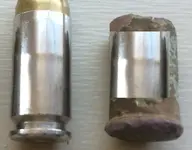Tommy G
Bronze Member
I just returned from a six day hunt yesterday, so this will be my longest post ever! I got permission to hunt an 1868 estate (100+ acres), original home and out buildings still standing. The property is documented back to the original 1660 land patent granted by King Charles II. The land boarders the Potomac River. The owner introduced me to a local archaeologist that has been documenting the area for the past 25 years. Before my hunt began, I toured the property with him for about two hours, soaking up the history this guy had accumulated. Probably the most important history shared with me was the fact that there used to be a large pier on the river that served as a major cargo port from the mid to late 1700's. He was even able to point out the path the wagons took as they ventured to and from port. In total, I spent six full days hunting the area and managed to pull together some nice finds, some of which you see the in the table wrap up photo below. Most of the finds were found along the old wagon road, others closer to the house which has been occupied and passed down through multiple generations. Because of the long, documented history of this land, I expected to find an lot of cross-generation relics, which was the case.
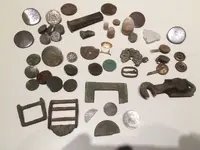
Now to some close ups. This pewter USA button was found along the old road about 100 yards from the shoreline where the pier connected.
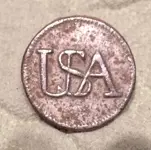
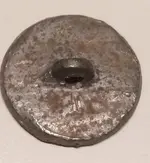
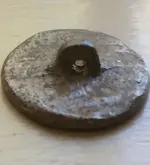
Before l left on Saturday, I met again with the archaeologist to show him this button and a few other finds. After closely examining the button, he said he could find no reason to believe this was not an authentic Continental Army enlisted button. I even argued with him due to the remarkable condition it was in. He told me there were multiple patterns of this button produced, some of poor quality, others of much better quality. He then commented on the excellent soil condition as a contributing factor, and went on the point out the excellent condition of the 1781 reale that I found not 20 yards away from this button.
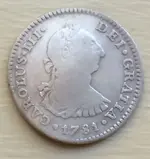
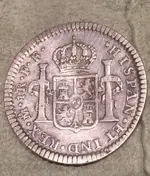
In fact, I found a half real, a couple of cut reales and a cut copper as well.
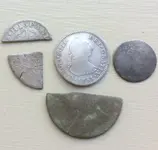
I can barely make out part of a bust on the cut copper. The back has no detail. Would love to hear your ideas on this one.
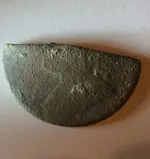
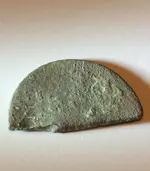
Then I stumbled on to this beautiful dropped, 50+ caliber three ringer.
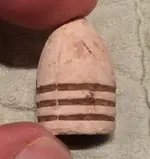
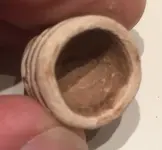
And a smaller one, maybe in the .32 caliber range that may or may not be period. Opinions welcome.
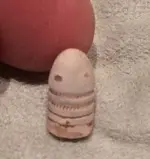
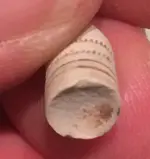
A nice convex sliver button with pattern.
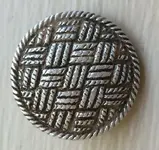

A gold cuff link, both pieces found in the hole.
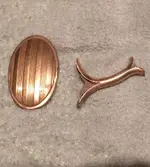
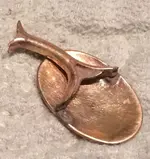
Some mystery buttons. The shank tells me 18th century, but the finish is very odd. All are quarter size. Again, comments welcome.
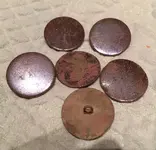
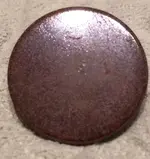
Several of these. All with Waterbury Conn on the back. The website refers to these as hat buttons. Not sure of age, but found three, this one being the best condition.
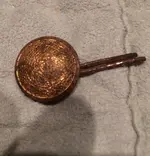
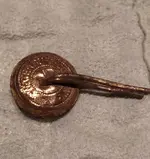
Several pieces of large caliber rim fire brass, these two being the best examples. Both have two strike marks on them, indicating a misfire on the first shot. I have an .40 S&W for sizing comparison, these a slightly larger.
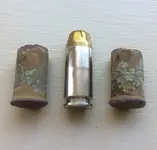
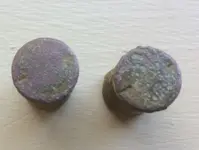
Part of a colonial buckle frame and knee buckle frame.
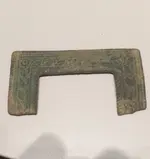
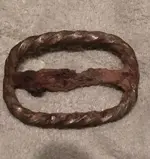
Not going to post close ups the tombacs and flat buttons, but multiple sizes were found. I will end this post with a real head-scratcher. What appears to be (according to my research) a King George VI Royal Engineers button (WWII era). I have found a couple of identical examples on the internet, one stating that it was made by C. Pitt & Co. However, I've not found any photos that show a back mark. In fact, I've not been able to find a single C. Pitt back mark example, leading me to believe they had none. Anyway, not sure of the authenticity of this one. All I can say is that I found it several inches deep on a high ridge line, overlooking the Potomac.
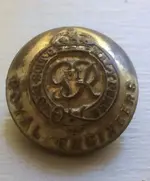
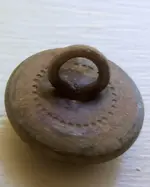
I could go on forever, but will cut this short Thanks for checking out the post, and if you want a close up, or have any questions about the other finds in wrap up photo, just let me know.
Thanks for checking out the post, and if you want a close up, or have any questions about the other finds in wrap up photo, just let me know.

Now to some close ups. This pewter USA button was found along the old road about 100 yards from the shoreline where the pier connected.



Before l left on Saturday, I met again with the archaeologist to show him this button and a few other finds. After closely examining the button, he said he could find no reason to believe this was not an authentic Continental Army enlisted button. I even argued with him due to the remarkable condition it was in. He told me there were multiple patterns of this button produced, some of poor quality, others of much better quality. He then commented on the excellent soil condition as a contributing factor, and went on the point out the excellent condition of the 1781 reale that I found not 20 yards away from this button.


In fact, I found a half real, a couple of cut reales and a cut copper as well.

I can barely make out part of a bust on the cut copper. The back has no detail. Would love to hear your ideas on this one.


Then I stumbled on to this beautiful dropped, 50+ caliber three ringer.


And a smaller one, maybe in the .32 caliber range that may or may not be period. Opinions welcome.


A nice convex sliver button with pattern.


A gold cuff link, both pieces found in the hole.


Some mystery buttons. The shank tells me 18th century, but the finish is very odd. All are quarter size. Again, comments welcome.


Several of these. All with Waterbury Conn on the back. The website refers to these as hat buttons. Not sure of age, but found three, this one being the best condition.


Several pieces of large caliber rim fire brass, these two being the best examples. Both have two strike marks on them, indicating a misfire on the first shot. I have an .40 S&W for sizing comparison, these a slightly larger.


Part of a colonial buckle frame and knee buckle frame.


Not going to post close ups the tombacs and flat buttons, but multiple sizes were found. I will end this post with a real head-scratcher. What appears to be (according to my research) a King George VI Royal Engineers button (WWII era). I have found a couple of identical examples on the internet, one stating that it was made by C. Pitt & Co. However, I've not found any photos that show a back mark. In fact, I've not been able to find a single C. Pitt back mark example, leading me to believe they had none. Anyway, not sure of the authenticity of this one. All I can say is that I found it several inches deep on a high ridge line, overlooking the Potomac.


I could go on forever, but will cut this short
 Thanks for checking out the post, and if you want a close up, or have any questions about the other finds in wrap up photo, just let me know.
Thanks for checking out the post, and if you want a close up, or have any questions about the other finds in wrap up photo, just let me know.
Upvote
33



 Awesome finds. The button is in amazing condition. I am a coin shooter at heart and would love to have dug those cut silvers as well as the others.
Awesome finds. The button is in amazing condition. I am a coin shooter at heart and would love to have dug those cut silvers as well as the others. That really sounds like an amazing property and I hope you can continue to hit it.
That really sounds like an amazing property and I hope you can continue to hit it. 